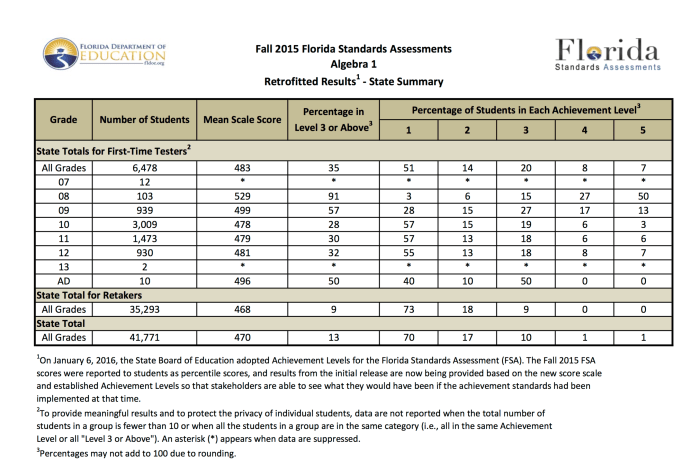The Algebra 1 EOC Formula Sheet Florida is an essential resource for students preparing for the End-of-Course (EOC) exam. This formula sheet provides a concise and organized summary of the key formulas and concepts covered in the Algebra 1 curriculum, including linear equations, inequalities, polynomials, factoring, quadratic equations, systems of equations, functions, data analysis, probability, and geometry.
By utilizing this formula sheet, students can efficiently review and reinforce the fundamental principles of Algebra 1, ensuring their success on the EOC exam and beyond.
Linear Equations
Linear equations are equations that can be written in the form Ax + B = C, where A, B, and C are constants and x is the variable. Linear equations can be solved using substitution or elimination.
Solving Linear Equations Using Substitution
- Solve for x in one of the variables (usually the one with the smaller coefficient).
- Substitute the value of x into the other equation.
- Solve for the remaining variable.
Solving Linear Equations Using Elimination
- Multiply both equations by a number so that the coefficients of one of the variables are opposites.
- Add the two equations together.
- Solve for the remaining variable.
Inequalities
Inequalities are equations that contain an inequality symbol ( <, >, ≤, ≥). Inequalities can be solved using the same methods as linear equations.
Solving Inequalities
- Solve the inequality as if it were an equation.
- Check your solution by plugging it back into the original inequality.
Graphing Inequalities
- Graph the line that represents the equation of the inequality.
- Shade the region that satisfies the inequality.
Polynomials
Polynomials are expressions that contain one or more variables and constants. Polynomials can be added, subtracted, and multiplied.
Adding and Subtracting Polynomials
- Combine like terms.
- Simplify the expression.
Multiplying Polynomials
- Use the distributive property to multiply each term of the first polynomial by each term of the second polynomial.
- Simplify the expression.
Factoring

Factoring is the process of writing an expression as a product of its factors. Polynomials can be factored using the greatest common factor (GCF) or the difference of squares.
Factoring Polynomials Using the GCF
- Find the GCF of all the terms in the polynomial.
- Factor out the GCF.
- Factor the remaining polynomial.
Factoring Polynomials Using the Difference of Squares
- Find the difference of squares in the polynomial.
- Factor the difference of squares.
- Simplify the expression.
Quadratic Equations
Quadratic equations are equations that can be written in the form ax² + bx + c = 0, where a, b, and c are constants and x is the variable. Quadratic equations can be solved using the quadratic formula or by completing the square.
Solving Quadratic Equations Using the Quadratic Formula
- Use the quadratic formula to solve for x.
- Simplify the solution.
Solving Quadratic Equations by Completing the Square
- Add and subtract the square of half the coefficient of x to both sides of the equation.
- Factor the left side of the equation.
- Solve for x.
Systems of Equations
Systems of equations are sets of two or more equations that are solved simultaneously. Systems of equations can be solved using substitution or elimination.
Solving Systems of Equations Using Substitution
- Solve one of the equations for one of the variables.
- Substitute the value of the variable into the other equation.
- Solve for the remaining variable.
Solving Systems of Equations Using Elimination
- Multiply both equations by a number so that the coefficients of one of the variables are opposites.
- Add the two equations together.
- Solve for the remaining variable.
Functions: Algebra 1 Eoc Formula Sheet Florida
Functions are relations that assign a unique output to each input. Functions can be represented graphically, algebraically, or verbally.
Different Types of Functions
- Linear functions
- Quadratic functions
- Exponential functions
- Logarithmic functions
Graphing Functions
- Plot the points that satisfy the function.
- Connect the points with a smooth curve.
Data Analysis
Data analysis is the process of collecting, organizing, and interpreting data. Data analysis can be used to make predictions, draw conclusions, and solve problems.
Creating Scatter Plots
- Plot the data points on a graph.
- Draw a line of best fit through the points.
Finding the Line of Best Fit
- Use the least squares method to find the line that best fits the data.
- Write the equation of the line.
Probability
Probability is the measure of the likelihood that an event will occur. Probability can be calculated using the formula P(E) = n(E)/n(S), where P(E) is the probability of event E, n(E) is the number of outcomes in event E, and n(S) is the total number of possible outcomes.
Calculating Probability
- Identify the event you are interested in.
- Count the number of outcomes in the event.
- Count the total number of possible outcomes.
- Use the formula P(E) = n(E)/n(S) to calculate the probability.
Using Probability to Solve Problems
- Use the probability of an event to make predictions.
- Use the probability of an event to make decisions.
Geometry
Geometry is the study of shapes and their properties. Geometry can be used to solve problems in a variety of fields, including architecture, engineering, and design.
Calculating the Area and Perimeter of Geometric Shapes, Algebra 1 eoc formula sheet florida
- Use the appropriate formula to calculate the area or perimeter of the shape.
- Simplify the expression.
Using Geometry to Solve Problems
- Use the properties of shapes to solve problems.
- Use the relationships between shapes to solve problems.
FAQ Corner
What is the purpose of the Algebra 1 EOC Formula Sheet Florida?
The Algebra 1 EOC Formula Sheet Florida provides a concise summary of key formulas and concepts covered in the Algebra 1 curriculum, assisting students in their preparation for the End-of-Course (EOC) exam.
What topics are covered in the Algebra 1 EOC Formula Sheet Florida?
The formula sheet covers a wide range of topics, including linear equations, inequalities, polynomials, factoring, quadratic equations, systems of equations, functions, data analysis, probability, and geometry.
How can students use the Algebra 1 EOC Formula Sheet Florida?
Students can use the formula sheet as a study guide, reviewing and reinforcing key concepts. It can also be used as a quick reference during the EOC exam, providing easy access to essential formulas.

